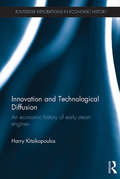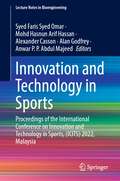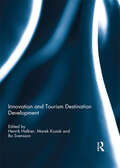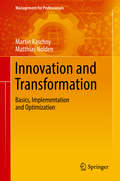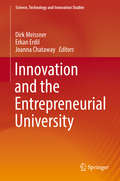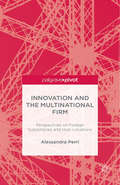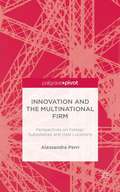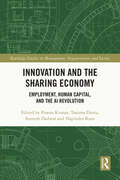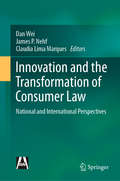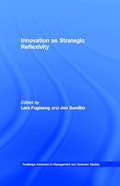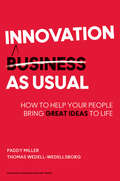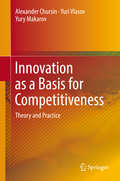- Table View
- List View
Innovation and Technological Diffusion: An economic history of early steam engines (Routledge Explorations in Economic History)
by Harry KitsikopoulosThis book deals with two key aspects of the history of steam engines, a cornerstone of the Industrial Revolution, specifically the road that led to its discovery and the process of diffusion of the early steam engines. The first part of the volume outlines the technological and scientific developments which took place between the 16th and 18th centuries, proving critical for the invention of this strategic technology. The most important question addressed is why did England come up with this innovation first as opposed to other countries (e.g., France, Italy), which were more advanced in terms of knowledge pertinent to it. The second part of the volume traces the process of diffusion of the early steam engines, the Newcomen model, through to 1773, the year prior to the first commercial application of the second generation of steam engines (the Watt model). The process of diffusion is quantified on the basis of a novel method before proceeding with a discussion of the main determinants of this process. Kitsikopoulos pulls together a large amount of relevant evidence found in primary sources and more technically oriented literature which is often ignored by economic historians. This book will be of interest to economic historians and historians of technology.
Innovation and Technology
by Chicago Tribune StaffCulled from the pages of the Chicago Tribune, this collection of articles features the most relevant and recent business stories on innovation, entrepreneurship, and technology as reported by the award-winning Tribune columnists and reporters. Innovation and Technology encapsulates the cutting-edge developments in the tech world that are affecting large corporations, small business, start-ups, and consumers alike.Innovation and Technology is divided into three main sections: Innovation in Chicago, Profiles in Innovation, and Technology in the News. The Innovation in Chicago section discusses the latest start-ups in Chicago, as well as how innovative technologies (anywhere from 3D printing to so-called "civic" apps) are being used by businesses and institutions throughout the Windy City.The Profiles in Innovation section is full of fascinating interviews with thought leaders, business owners, CEOs, and entrepreneurs from the Midwest and Greater Chicagoland area. Finally, the Technology in the News section gathers the big tech stories of 2013, from Google Glass to the latest investments in burgeoning new companies. Extensive first-person interviews and in-depth reporting by the Chicago Tribune makes Innovation and Technology a broad yet detailed look at the larger concept of innovation and how it pertains to individuals and businesses on the local level.
Innovation and Technology in Sports: Proceedings of the International Conference on Innovation and Technology in Sports, (ICITS) 2022, Malaysia (Lecture Notes in Bioengineering)
by Mohd Hasnun Arif Hassan Anwar P. P. Abdul Majeed Syed Faris Syed Omar Alexander Casson Alan GodfreyThis book presents the proceedings of ICITS 2022 covering different tracks in the field of Sports Engineering and Technology, namely, Instrumentation, Materials, Data Analytics, Biomechanics, Simulation, Equipment Design and Performance Analysis, amongst others. This collection of articles deliberates the key challenges as well as technological innovations that facilitate the enhancement of sporting performance. The readers are expected to gain an insightful view on the current trends, issues, mitigating factors, technological innovations as well as proposed solutions.
Innovation and Technology: Business and economics approaches (Routledge Advanced Texts in Economics and Finance)
by Nikos VernardakisInnovation has revolutionized the world economy, yet it remains often misunderstood. This textbook seeks to elucidate the nature and impact of innovation for both undergraduate and graduate students. Innovation and Technology examines the impact of innovation on both economic theory and the real world. It addresses the topic at the level of policy and also drills down to provide analysis of firms. This book moves beyond the plethora of specialized studies on the subject and formulates a unified and comprehensive approach, encompassing the topic’s huge breadth and scope. Issues such as innovation, knowledge, incentives, information and regulation are featured. Designed for MBA, Economics and Business students, this textbook will be useful to those interested in innovation, entrepreneurship and the economics of technology.
Innovation and Tourism Destination Development
by Henrik Halkier, Marek Kozak and Bo SvenssonTourism is a central part of regional development strategies in many localities around Europe, not just in traditional coastal or mountain resorts but also in areas without a strong track record with regard to visitor economy. In a globalising world, destinations can no longer take their traditional visitors for granted and escape growing competitive pressures, because increasingly experienced, specialised and demanding travellers now have a vastly greater number of potential destinations to choose from. Both well-established and emerging tourist destinations are therefore under pressure to be innovative to increase their attractiveness in the globalising visitor economy. This book focuses on the role played by tourist destinations – conceived as multi-layered and functional governance structures – in stimulating or complicating the development of new tourist experiences. The complex relationship between firm-level and territorial development dynamics is, of course, by no means confined to tourism development, and the book will therefore be of a more general relevance for research into innovation and spatial development dynamics.This book was published as a special issue of European Planning Studies.
Innovation and Transformation: Basics, Implementation And Optimization (Management For Professionals)
by Martin Kaschny Matthias NoldenThis book discusses a six-step transformation cycle in which the tasks of innovation management – ranked according to their relevance for companies – are placed in a systematic order. Presenting an in-depth discussion on innovation and transformation, the authors delve into strategic themes such as business models and strategic positioning, which are fundamental to the innovation process. It also describes the underlying processes and roles of innovation management, and the required organizational structures. Following process organization and organizational structure, the authors highlight how the appropriate human resource strategy should look and the manner of personnel selection or development to be implemented. The authors also provide tools and systems that are assigned to specific employees working with innovation management; these deal with innovation audit, knowledge management, idea management, financing and budgeting innovations, marketing and property rights. The book also sheds light on how the effectiveness of the innovation process can be monitored using indicator systems. This is a handy resource for managers looking for a structured strategy and how to implement it to achieve optimal innovation management and reap its benefits.
Innovation and the Entrepreneurial University (Science, Technology and Innovation Studies)
by Dirk Meissner Erkan Erdil Joanna ChatawayThe book explores different approaches towards the ‘entrepreneurial university’ paradigm, explores channels and mechanism used by universities to implement the paradigm and contributes to the public discussion on the impact of commercialization on university research and knowledge. It argues that different types of university-industry interaction may have repercussions even on funding of basic research if an appropriate balance is ensured between the two. University activities – both research and education in all forms – should provide economic and social relevance directed towards open science and open innovation. This book adds value to current knowledge by presenting both a conceptual framework and case studies which describe different contexts.
Innovation and the Evolution of Industries
by Malerba, Franco and Nelson, Richard R. and Orsenigo, Luigi and Winter, Sidney G. Franco Malerba Richard R. Nelson Luigi Orsenigo Sidney G. WinterThe disruptive impacts of technological innovation on established industrial structures has been one of the distinguishing features of modern capitalism. In this book, four leading figures in the field of Schumpeterian and evolutionary economic theory draw on decades of research to offer a new, 'history-friendly' perspective on the process of creative destruction. This 'history-friendly' methodology models the complex dynamics of innovation, competition and industrial evolution in a way that combines analytical rigour with an acknowledgement of the chaotic nature of history. The book presents a comprehensive analysis of the determinants and patterns of industrial evolution, and investigates its complex dynamics within three key industries: computers, semiconductors, and pharmaceuticals. It will be of great value to scholars and students of innovation and industrial change, from backgrounds as varied as history, economics and management. Its coverage of new methodological tools is also useful for students who are new to evolutionary economic theory.
Innovation and the Future Proof Bank
by Gardner James AInnovation, the conversion of the new to business as usual, is a very special business process. It is the business process able to reprogram all others. Creating the practices that make this process work is a key challenge for all in financial services that are worried about responding to the future. When an institution can identify things that are outside its present practices and convert them, production line style, into products, processes, cultural changes, or new markets, it will never be outpaced by internal or external change again. The institution becomes "FutureProof". This is a book about those practices in banks. It explains, using examples from institutions around the world, what it takes to create an innovation culture that consistently introduces new things into undifferentiated markets and internal cultures. It shows how banks can leverage the power of the new to establish unexpected revenue lines, or make old ones grow. And it provides advice on the social and political factors that either help or hinder the germination of the new in banks. Moreover, though, this is a book about the science of innovation in a banking context. Drawing from practices already highly developed in financial services-managing portfolios of assets to mitigate risk-it explains how practitioners can run their innovations groups like any other business line in the bank one that delivers a return on investment predictably and at high multiples of internal cost of capital. For leaders, Innovation and the Future Proof Bank provides the diagnostic tools to guide benchmarking and investment decisions for the innovation function. And for innovation practitioners, the book lays out everything needed to make sure that converting the new to business as usual is predictable, measurable, and profitable.
Innovation and the Multinational Firm: Perspectives on Foreign Subsidiaries and Host Locations
by A. PerriIn the changing geography of innovation, multinational corporations play a key role as creators of knowledge. Innovation and the Multinational Firm investigates how innovation is managed within these firms by focusing particularly on subsidiaries and host-locations.
Innovation and the Multinational Firm: Perspectives on Foreign Subsidiaries and Host Locations
by Alessandra PerriInnovation and the Multinational Firm.
Innovation and the Sharing Economy: Employment, Human Capital, and the AI Revolution (Routledge Studies in Management, Organizations and Society)
by Pawan Kumar Sumesh Dadwal Tanima Dutta Napinder KaurThis book is a novel exploration of the complex interplay between modern work structures, artificial intelligence (AI), and economic sustainability.Through meticulously researched insights and real-world examples, this book unravels the intricate dynamics shaping the sharing and gig economies, offering a comprehensive analysis of their implications for the future of work. Key features of this book include a deep dive into the theoretical foundations of AI, the sharing economy, and gig economy, complemented by practical case studies illustrating their real-world applications. Readers will gain valuable insights into how these economic models influence labour markets, technological advancements, governance frameworks, and societal well-being. By examining the opportunities and challenges presented by the sharing and gig economies, this book equips readers with the knowledge to navigate and shape the evolving landscape of work.This edited collection caters to a diverse audience, including academics, technologists, policymakers, students across various disciplines, and professionals interested in the future of work and economic development. Its interdisciplinary approach makes it an invaluable resource for those seeking a deeper understanding of the complexities surrounding AI, the sharing economy, and the gig economy. Whether you're a researcher, entrepreneur, or policymaker, this book provides essential insights into the transformative forces shaping the global economy.
Innovation and the State: Finance, Regulation, and Justice
by Cristie FordFrom social media to mortgage-backed securities, innovation carries both risk and opportunity. Groups of people win, and lose, when innovation changes the ground rules. Looking beyond formal politics, this new book by Cristie Ford argues that we need to recognize innovation, and financial innovation in particular, as a central challenge for regulation. Regulation is at the leading edge of politics and policy in ways that we have not yet fully grasped. Seemingly innocuous regulatory design choices have clear and profound practical ramifications for many of our most cherished social commitments. Innovation is a complex phenomenon that needs to be understood not only in technical terms, but also in human ones. Using financial regulation as her primary example, Ford argues for a fresh approach to regulation, which recognizes innovation for the regulatory challenge that it is, and which binds our cherished social values and our regulatory tools ever more tightly together.
Innovation and the Transformation of Consumer Law: National and International Perspectives
by Dan Wei Claudia Lima Marques James P. NehfThis book covers technologies that pose new challenges for consumer policy, creative developments that can help protect consumers’ economic interests, innovative approaches to addressing perennial consumer concerns, and the challenges entailed by emerging ways of creating and delivering consumer products and services. In addition, it reflects on past successes and failures of consumer law and policy, explores opportunities for moving consumer law in a different direction, and discusses potential threats to consumer welfare, especially in connection with the changing political landscape in many parts of the world. Several chapters examine consumer law in individual countries, while others have an international focus.
Innovation as Social Change in South Asia: Transforming Hierarchies
by Minna Säävälä and Sirpa TenhunenThis book examines innovation as social change in South Asia. From an anthropological micro-perspective, innovation is moulded by social systems of value and hierarchy, while simultaneously having the potential to transform them. Peterson examines the printing press’s changing technology and its intersections with communal and language ideologies in India. Tenhunen explores mobile telephony, gender, and kinship in West Bengal. Uddin looks at microcredit and its relationship with social capital in Bangladesh. Jeffrey surveys imbalanced sex ratios and the future of marriage payments in north-western India. Ashrafun and Säävälä investigate alternative dispute resolution as a social innovation which affects the life options of battered young wives in Sylhet, Bangladesh. These case studies give insights into how the deeply engrained cultural models and values affect the forms that an innovative process can take. In the case of some South Asian societies, starkly hierarchical and holistic structures mean that innovations can have unpredictable sociocultural repercussions. The book argues that successful innovation requires taking into account how social hierarchies may steer their impact.This book was originally published as a special issue of Contemporary South Asia.
Innovation as Strategic Reflexivity (Routledge Advances In Management And Business Studies)
by Lars Fuglsang Jon SundboThis book presents a new view of innovation, seeking to disclose how strategic reflexivity is embodied in specific innovation practices and management roles.From an evolutionary point of view, the contributors argue that firms and organisations are increasingly forced to take into account the growing complexity of the environment. To do this, they
Innovation as Usual
by Paddy Miller Thomas Wedell-WedellsborgTurn team members into innovatorsMost organizations approach innovation as if it were a sideline activity. Every so often employees are sent to "Brainstorm Island": an off-site replete with trendy lectures, creative workshops, and overenthusiastic facilitators. But once they return, it's back to business as usual.Innovation experts Paddy Miller and Thomas Wedell-Wedellsborg suggest a better approach. They recommend that leaders at all levels become "innovation architects," creating an ecosystem in which people engage in key innovation behaviors as part of their daily work.In short, this book is about getting to a state of "innovation as usual," where regular employees-in jobs like finance, marketing, sales, or operations-make innovation happen in a way that's both systemic and sustainable.Instead of organizing brainstorming sessions, idea jams, and off-sites that rarely result in success, leaders should guide their people in what the authors call the "5 + 1 keystone behaviors" of innovation: focus, connect, tweak, select, stealthstorm, (and the + 1) persist: Focus beats freedom: Direct people to look only for ideas that matter to the business Insight comes from the outside: Urge people to connect to new worlds First ideas are flawed: Challenge people to tweak and reframe their initial ideas Most ideas are bad ideas: Guide people to select the best ideas and discard the rest Stealthstorming rules: Help people navigate the politics of innovation Creativity is a choice: Motivate everyone to persist in the five keystone behaviorsUsing examples from a wide range of companies such as Pfizer, Index Ventures, Lonza, Go Travel, Prehype, DSM, and others, Innovation as Usual lights the way toward embedding creativity in the DNA of the workplace.So cancel that off-site. Instead, read Innovation as Usual-and put innovation at the core of your business.
Innovation as a Basis for Competitiveness
by Alexander Chursin Yuri Vlasov Yury MakarovThis book focuses on the theory and practice involved in the management of innovative activities that enhance the competitiveness of enterprises, industries and economies. It presents a multi-criteria approach to the problem of selecting effective innovative projects and innovative technologies that increase competitiveness in high-tech industries. Further, the book develops a mathematical risk assessment model, and proposes new approaches for systematically identifying and assessing the probability of risk emergence. Lastly, it demonstrates how simulation models can be used to assess the impact of innovative technologies on the competitiveness of high-tech products.
Innovation as a Game of Chutes and Ladders
by James M. UtterbackThis chapter draws together some earlier lessons and academic research to consider the relationship between the behaviors and strategies of firms with respect to technological innovation and long-term survival.
Innovation at 3M Corp. (A)
by Stefan Thomke Ashok NimgadeDescribes how 3M Corp. introduces and learns a new and innovative methodology called Lead User research to understand future customer and market needs. A team from 3M's Medical-Surgical Markets Division applies the Lead User methodology to the field of surgical infection control and discovers not only new product concepts but also a very promising new business strategy. Focuses on: (1) 3M's approach to the management of innovation and understanding market needs, (2) an in-depth description of the Lead User method and its potential as applied to the medical business, and (3) the managerial challenges of introducing novel methods into a successful organization.
Innovation at Mahindra & Mahindra (A)
by Stefan Thomke Briana Doerr LuthraDescribes the Mahindra & Mahindra Group's approach to innovation. The Group is among the top industrial houses in India and its managing director Anand Mahindra has put innovation at the core of its growth strategy. Emphasis is placed on managing the balance between structured processes and the creation of an environment in which radical innovations can succeed. The Farm Equipment Sector, one of the Group's largest and most successful sectors, is developing a revolutionary tractor outside its conventional development process with the help of a "Maverick" innovator. Not surprisingly, the project encounters numerous obstacles and setbacks. Focuses on: 1) the role of creative innovators in breakthrough innovations; 2) the need for process, structure and early feedback from markets; 3) the sources of radical product concepts; and 4) the marketing of innovations.
Innovation at Progressive (A): Pay-As-You-Go Insurance
by Frances X. Frei Hanna Rodriguez-FarrarConsumer auto insurance is a price-sensitive industry in which customers rarely pay a premium to a provider even for additional service features. Progressive spends more on additional service features than its competitors do; consumers don't pay extra for these features, yet the company makes money on a product its competitors often do not. Central to Progressive's success is its ability (a) to turn operational savings into value-added service and (b) to capitalize on its unique competencies through clever service design. Progressive is considering a national rollout of Autograph, a pay-as-you-go insurance service offering that recently completed a successful pilot in Texas.
Innovation at Progressive (B): Homeowners Insurance
by Frances X. Frei Hanna Rodriguez-FarrarAnalyzes whether Progressive, strictly an auto insurer, should enter the home owner's insurance market. The critical decision is whether the competencies that made Progressive succeed in the auto insurance industry can translate to the home owner's insurance industry.
Innovation at Timberland: Thinking Outside the Shoe Box
by Rosabeth Moss Kanter Ryan RaffaelliInnovation was linked to Timberland's heritage. In 2005, CEO Jeff Swartz and COO Ken Pucker hoped the Invention Factory, an advanced concept lab, would develop new breakthrough products and reinvigorate the company's culture of innovation. Since the 1960s, Timberland had relied on innovation, developing the world's first waterproof boot and, in the 1980s, category-defining boat shoes and day hiking boots. Creating variations of these core products, along with expansion into apparel, had sustained Timberland's business for more than 30 years. Timberland's growth in the past six years was due to increased international sales and new customer segments. As Timberland's leaders looked to the future, they hoped Doug Clark, a biomechanist, and his Invention Factory team would bring a scientific approach toward building the next generation of Timberland products and ideas. The team had to convince those in the mainstream business to accept their new ideas and integrate them back into the product line.
